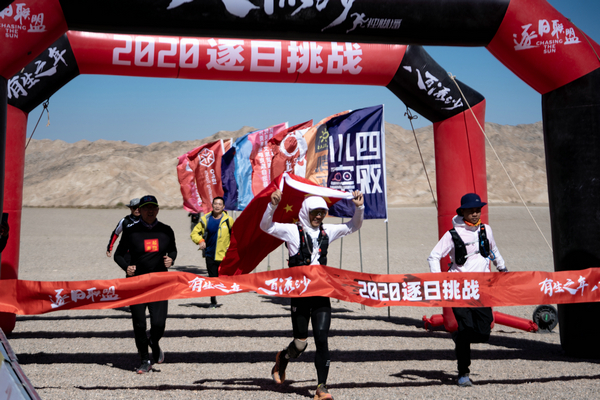 |
|
Pan (center) crosses the finish line in Guazhou, Gansu province, on Sept 18, flanked by members of his support team. [Photo provided to China Daily] |
An accidental realization
He can still remember it. The car veering out of control. The sound of metal being ripped as the vehicle crashed into the guardrail on a Shanghai street in the spring of 2015. Before the accident he owned an exhibition company that was suffering difficulties and he had been working for two nights without sleep. The guardrail that punctured the car was driven into his right leg like a stake, and he lost consciousness before the ambulance arrived. When he woke up, his lower right leg was gone. The accident was a catastrophic blow to Pan and his family. It marked a turning point.
Pan was bedridden for three months, he says. "During this period, I kept asking myself three questions: Was I satisfied with my life before the accident? If there is a second chance, will I reset my life? If it is time to start over, what should I do?"
When a friend invited him to hike in the Gobi Desert in 2016, Pan knew the answer to his third question.
After he read about South African double-amputee sprinter Oscar Pistorius, he was confident that one day he would not just stand up once more, but would run. He set himself the goal of one day breaking the world record for the longest distance race run by an amputee athlete.
His first target was the 108 km hiking challenge in Dunhuang Gobi Desert one year later.
But adjusting to a prosthesis took longer, and was harder, than he first thought.
In the beginning, he could hardly bear the intense pain caused by the friction between his leg and the prosthesis. He stumbled countless times. When taking a shower, he had to remove his prosthesis and crawl into the bathroom to avoid falling.
When the pain seemed unbearable, he simply recalled the day of the accident.
To realize his hiking goal, Pan formulated a comprehensive training plan, based on the methods applied by track-and-field athletes.
In April 2016, he became China's first amputee to complete the 108 km desert hike within the given time-four days.
Following the desert race, he established a dozen or so firsts for below-the-knee amputees. These included completing the 2018 Ironman 70.3 Xiamen's 113 km triathlon in 7 hours 26 minutes, finishing the Gangshika Xtrial's 100 km race in 27 hours and 40 minutes, and successfully conquering the Ironman Western Australia in 2019, which involves swimming for 3.8 km, cycling for 180 km and running for 42.2 km. As a result he has been dubbed "the Chinese blade runner "and his autobiography was published in May 2019.
"My experience proves that everyone can run a little further than they think," Pan says.
Pan is already back on the running machine, preparing for his next challenge-swimming and sailing across the Taiwan Straits.
"It is still in the feasibility study stage, because swimming across the 130 km Straits is physically impossible. I have been consulting experts to explore its practicality," Pan says.
"I do not challenge nature, but challenge myself in the natural environment," Pan says, adding that respect for nature and risk management are very important for extreme sports athletes.
"Life's meaning is to explore the unknown," he claims.
Just as his favorite song, Zayde Wolf's Born Ready, goes: "I'm gonna push up higher/I'm gonna do what I do/I won't shiver/I won't shake/I'm made of stone/I don't break."
Contact the writer at wangqian@chinadaily.com.cn